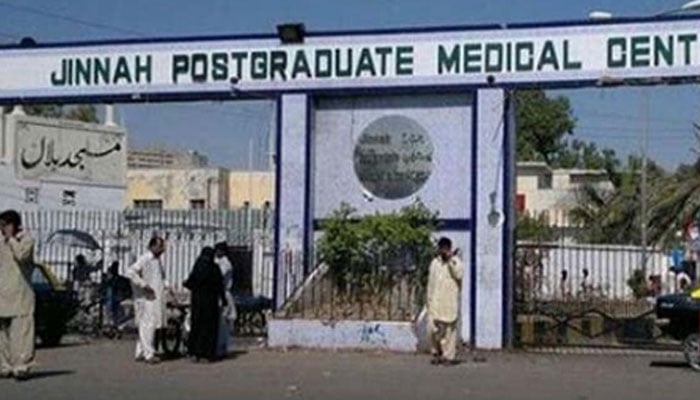Why are Karachi’s hospitals getting more DOAs, near-death patients?
When a 35-year-old woman was brought dead to the Jinnah Postgraduate Medical Centre’s (JPMC) emergency this past Saturday, the doctors on duty decided to get her chest X-rayed, because for the last several days, they had been observing an increase in the number of patients either being brought in dead or dying within hours of their arrival.
“The examination of the X-ray of the deceased woman revealed that there was a large patch on her lungs, which indicated that she was suffering from some kind of lower respiratory tract illness,” revealed the doctor on emergency duty.
“I sent the X-ray to a well-known pulmonologist, who is treating COVID-19 patients at a tertiary-care hospital, and his reply confirmed my fears. ‘It is most probably COVID pneumonia’ was the answer of the chest specialist.”
Besides the woman with the fluid-filled lungs, more than 300 such patients have been brought to different public and private hospitals in the past 15 days — all of them either dead on arrival (DOA) or extremely sick with “pneumonia-like symptoms”, who died within hours of their arrival, said health officials.
Unfortunately, they said, except for a few such patients whose bodies were sent for an X-ray, majority of the deceased were neither examined for ascertaining the cause of their death nor sent for a post-mortem examination.
Most likely causes of their deaths were “severe illnesses” — ranging from chronic liver disease, multiple organ failure and cardiopulmonary arrest to renal failure, pneumonia and even acute respiratory distress syndrome (ARDS), added the officials.
“We started observing this trend by the end of last month, when we saw that the number of patients requiring emergency treatment had declined from 1,800-2,000 to 600-700 a day,” said the critical care specialist at the JPMC.
“But the number of people who either were dead on arrival or died within a couple of hours after their arrival increased with every passing day. Initially, we didn’t pay any heed, but now we’re seeing a pattern. And this is also being reported by other hospitals.”
He said he started noticing the unusual pattern of DOAs and near-death patients from March 31, when seven bodies were brought in — of which one death was due to a road accident — and seven other patients who were brought in alive died before they could be moved to the wards.
“The next day, seven more people were brought in dead and four died during treatment at the emergency. On April 2, seven again were brought in dead while seven died during treatment at the emergency,” said the doctor.
“During the next few days, the number of those brought in dead and those who died during treatment started rising. And on Monday, eight patients were brought in dead while eight died during treatment at the JPMC emergency.”
The emergency medicine specialist said that all these people were in the 45-60 age group, except for a few who were older and a few who were younger like the woman who was brought in dead with lung disease. People in this age group normally don’t die suddenly, he added.
“People between 45 and 60 years of age usually take a few days’ time, while some of them even respond to emergency treatment, but here we are witnessing a strange phenomenon.”
Since March 31, said emergency officials, 109 patients have been brought in dead and 90 who were alive when brought to the JPMC emergency but died mysteriously, and their bodies were handed over to their heirs without ascertaining their cause of death.
Other hospitals
Officials at other public and private hospitals showed reluctance in sharing data with The News on DOAs or on those who died during treatment at their emergencies. They, however, admitted that the number of cases with “pneumonia-like symptoms” is on the rise, and many of those being brought in dead have symptoms of pneumonia or ARDS, which is thought to be caused by the coronavirus.
An official at the Indus Hospital Karachi confirmed that the number of people with severe acute illness had increased during the past two and a half weeks, while daily two to four people were being brought dead to their emergency with pneumonia-like symptoms.
“Since we have a relatively smaller casualty compared to public hospitals, we refer such critically sick patients to either the JPMC or the Civil Hospital Karachi [CHK], while those who are brought in dead, their bodies are handed over to their families immediately.”
Similarly, an emergency care specialist at the National Institute of Cardiovascular Diseases confirmed receiving some patients who were either critically sick or were brought dead to their emergency.
The doctor said that instead of “classic symptoms of cardiac arrest”, those patients had respiratory and other illnesses, who either died before they could be shifted to other hospitals or were already dead when they were examined.
“Once a person is dead, their attendants and relatives hardly provide any history, and refuse to cooperate with the hospital administration. The staff on duty writes the cause of death on the death certificate without any detailed examination and as per the symptoms before handing over the body to the relatives. It’s very difficult to persuade the family for an autopsy to ascertain the cause of death.”
Officials at the city’s largest public hospital, the CHK, confirmed that the number of critically sick patients and DOAs had increased, but blamed it on the lockdown, saying that people were only bringing in their loved ones when it was absolutely necessary, resulting in the loss of several precious lives.
Sindh Health Department officials refused to comment on the report, but federal health authorities said that all of Pakistan’s 96 COVID-19 deaths, including 35 in Sindh, were brought in serious condition and “very late” to the hospitals, which also contributed to their passing away in addition to the lethal viral disease.
“Data indicates that patients with COVID-19 who have died spent only four days in hospitals and critical care units,” an official of the command & control centre on the novel coronavirus in Islamabad told The News. “This reveals that people are not opting for early treatment, and only go to the hospital when they are extremely sick.”
-
 ASAP Rocky Recalls 'embarrassing' First Meeting With Rihanna
ASAP Rocky Recalls 'embarrassing' First Meeting With Rihanna -
 Archie, Lilibet’s Chances At Meeting King Charles Get Promising Update: Here’s Why
Archie, Lilibet’s Chances At Meeting King Charles Get Promising Update: Here’s Why -
 Claire Foy Shares Rare Views On Typecasting Amid New Gig
Claire Foy Shares Rare Views On Typecasting Amid New Gig -
 Britney Spears Raves About Madonna In New Social Media Post
Britney Spears Raves About Madonna In New Social Media Post -
 Hailey Bieber Shares Sweet Snap Of Husband And Baby
Hailey Bieber Shares Sweet Snap Of Husband And Baby -
 Therapist Killed In Office As Former Client Launches Knife Attack
Therapist Killed In Office As Former Client Launches Knife Attack -
 Gaten Matarazzo Brands 'Stranger Things' Final Scene 'nerve-racking'
Gaten Matarazzo Brands 'Stranger Things' Final Scene 'nerve-racking' -
 David Beckham Speaks Out After Son Brooklyn Beckham's Shocking Post
David Beckham Speaks Out After Son Brooklyn Beckham's Shocking Post -
 Sophie Turner Gets Candid About 'imposter Sydrome' Post 'GOT'
Sophie Turner Gets Candid About 'imposter Sydrome' Post 'GOT' -
 When Nicola Peltz's Boyfriend Anwar Hadid Found Solace In Dua Lipa's Arms
When Nicola Peltz's Boyfriend Anwar Hadid Found Solace In Dua Lipa's Arms -
 Claire Foy Reveals Rare Impact Of 'The Crown' Gig On Career
Claire Foy Reveals Rare Impact Of 'The Crown' Gig On Career -
 Megan Thee Stallion Teases New Music On The Way
Megan Thee Stallion Teases New Music On The Way -
 Blonde Kate Stuns In Photos With Prince William During Rare Joint Engagement
Blonde Kate Stuns In Photos With Prince William During Rare Joint Engagement -
 Kate Gosselin Reveals Harrowing Moment Thief Nearly Took Her Down
Kate Gosselin Reveals Harrowing Moment Thief Nearly Took Her Down -
 Billy Bob Thornton Weighs In On Contrast To 'Landman' Role
Billy Bob Thornton Weighs In On Contrast To 'Landman' Role -
 Amanda Holden May Swap Position To Different Reality Show: See Which
Amanda Holden May Swap Position To Different Reality Show: See Which




